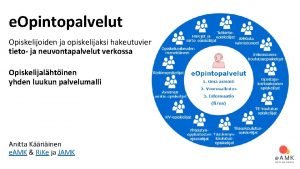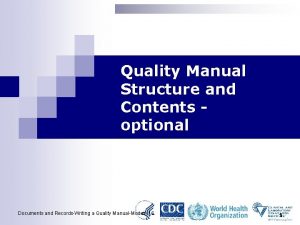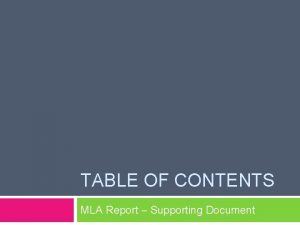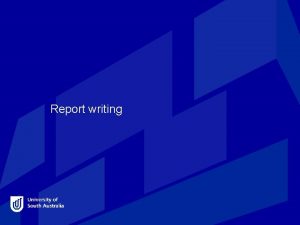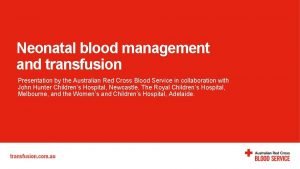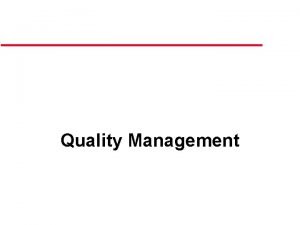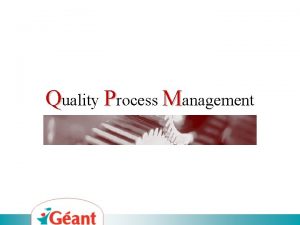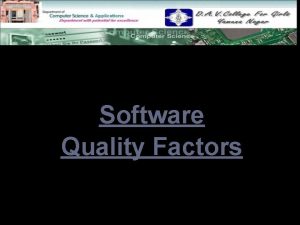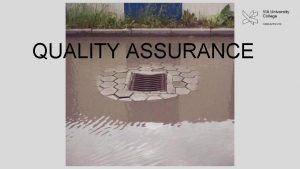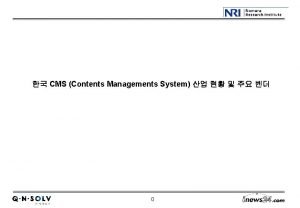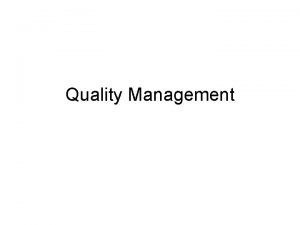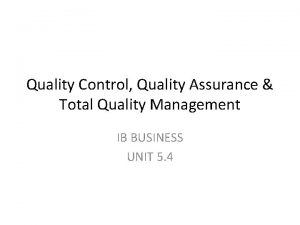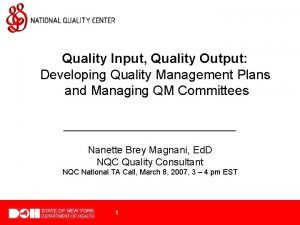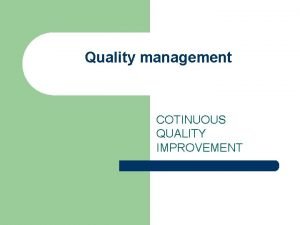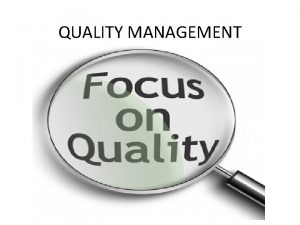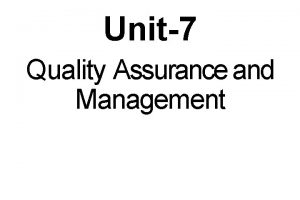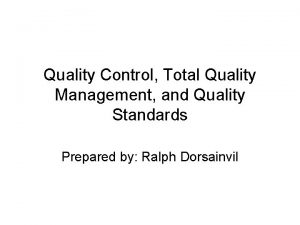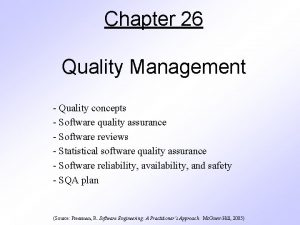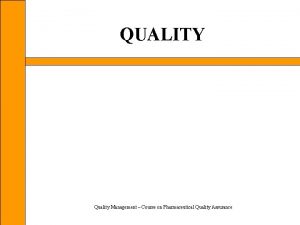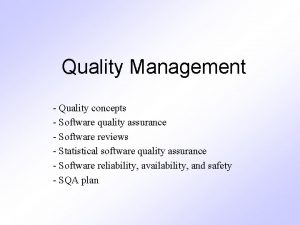Quality Management at Xamk Contents 1 Why do










































- Slides: 42


Quality Management at Xamk

Contents 1. Why do higher education institutions need quality management? 2. What does Xamk quality system consist of? 3. How does Xamk develop activities and what tools are used? 4. Who create quality at Xamk? 5. Where is Xamk heading?

Why do HEIs need quality management? • • • Finnish higher education institutions (HEIs) are responsible for the quality and continuous development of their education and other operations. HEIs are also required to undergo regular external evaluations of their operations and quality systems and to publish the results of such evaluations. (The Finnish UAS Act 932/2014, 14. 11. 2014 § 62) There are two aims for the quality assurance activities of HEIs: accountability and enhancement. These create trust in the performance and results of HEIs. (ESG, European Standards and Guidelines for Quality Management in Higher Education) The quality system provides information for the needs of management and operational steering. Evaluating and enhancing quality makes sure that Xamk meets the objectives and responds to the needs of stakeholders, customers and staff.

At Xamk we work for tomorrow. We are brave and interested in new developments and the world around us. Continuous evaluation and development of our quality are the essential part of that work.

What does Xamk quality system consist of? • • • Xamk quality systems follows the recommendations of the European Standards and Guidelines for Quality Assurance in Higher Education (ESG). This is ensured through the audit by the Finnish Education Evaluation Centre (FINEEC). Xamk’s quality system is part of its strategic planning, management and operational steering.

• Xamk quality management bases on the principle of continuous development of the PDCA model where the four stages form an iterative cycle: PLAN – DO – CHECK –ACT (PDCA) • The quality system consists of • quality policy • quality responsibilities • the methods and tools to continuously assess and improve the activities The quality management description outlines Xamk’s quality management and serves as a quality manual. That description is complemented by • Xamk’s process descriptions in the IMS management solutions software and the instructions and • guidelines available through the intranets for staff and/or students. •


Xamk quality system aims are to • • • systematically produce information to support the management and development of activities ensure that the information is used to support the development activities at all the levels of the organisation. clarify and harmonise the responsibilities of all actors concerning quality management. standardise the practices and to share good practices. support the participation of the Xamk community members – students, staff, and stakeholders – in developing the activities. strengthen the quality culture, ie the atmosphere of continuous development.

Continuos development in everyday work • • • All Xamk community members make efforts towards quality in our activities and in providing high-quality services for our students, customers and stakeholders. In assessing one’s own work and in making small improvements all Xamk community members can benefit from the information produced by Xamk quality system, such as course feedback, project assessment results or valuable daily observation as well as immediate feedback from students or other customers. Development ideas, their prompt testing and assessment of their functionality are important in terms of dynamic, agile and flexible operations.

Quality assessment and development involves improving activities and maintaining strengths, following targets and requirements, developing competence, meeting customer and stakeholder needs and streamlining processes.

Quality policy 1/2 • • Xamk values quality. The strategic management and operational steering base on the information systematically produced by the quality system. High-quality operations ensure Xamk’s societal impact that play an important role in its competitivity. Quality targets, their maintenance and improvement base on Xamk strategy and integrate into Xamk’s and its different units’ operations. Quality assessment and development tools selected involve efficient and economical methods and operation models that motivate students and staff in improving quality.

Quality policy 2/2 • • • Quality work follows the principles of transparency, reliability and confidentiality. The quality system and the data produced are documented on the staff and student intranets and on the Xamk website according to the user group needs. Communication on the information produced by the quality system is active.

How does Xamk develop activities and what tools are used? Processes Guidelines and instructions Quality tools Self-evaluations External evaluations Feedback enquiries Score cards Internal reviews Development discussions Development forums Measurement plan

Processes

Processes • • • Processes are described – to establish a common understanding of the operations – to enable better development and attention to activities that are relevant in terms of the process targets. Xamk’s core processes include education, RDI and operational steering processes They are complemented by support services which support our organisation’s operations and create a solid ground for successful core processes Processes include subprocesses. Processes are described in the IMS management solutions software according to Xamk’s common process instructions.

Instructions and guidelines 1. 2. • Statutory instructions, for example the degree regulation and SORA guidelines. • Oblige to all Xamk staff and actors. Guidelines for procedures • Common to entire Xamk, more comprehensive than a specific job description or a user guide. • Guidelines are drawn up following common instructions and using common templates. Stored in the Dynasty electronic records management system and made available through the intranet where the documents are arranged under the specific topic or operation type

EVALUATION AND FEEDBACK SYSTEM Management/ department Staff Students Stakeholder groups Scorecards Development discussion Internal reviews Self-evaluations Work community External evaluations development survey Equality survey Customer service surveys of support and business services Course feedback Arrival survey Stakeholder feedback Alumni feedback Education development survey Project evaluations and feedback Equality survey Graduand feedback Career monitoring survey questionnaire Customer service surveys of support enquiries of business services and business services

Principles of feedback system • • The feedback results are published. The results are processed openly by accounting for confidentiality and data protection. Students also receive feedback-on- feedback, in other words, information on the feedback received, possible development activities and their results on courses and through development forums. A measurement plan defines responsibility for data analysis and launching development activities. Feedback results are analysed in Board of Directors, workgroups, in meetings, on courses and on development forums.

Course feedback − − − Mid-course feedback and final course feedback on all courses The teachers collect mid-course feedback in a way that suits best to the course The teachers collect final course feedback with electronic form into common feedback system

Student surveys − The arrival survey collects information about the orientation related to starting of studies, the atmosphere, student tutoring and the student satisfaction. − All degree students respond during their first semester. − The education development survey helps to further develop the education, study counselling and student's self-steering, the learning environment and the general working environment. − All degree students respond in the middle of their studies. • The equality survey • Yearly at the same time with the education development survey

National student surveys • The graduand feedback questionnaire (AVOP) • Degree students respond approximately three weeks before graduation. • teaching and learning, internationality, multiculturalism and language studies, career services and connections with the working life, practical training, thesis and the general satisfaction for the studies • The career monitoring survey • Degree students who have graduated five years ago • Quality of employment and effectiveness of studies, career paths and how competences relate to demands of work

Development forums • • Staff, students and student union gathers together to – discuss the given feedback and students development ideas – agree on new actions – discuss the impact of earlier development measures. All departments of education or degree programmes have at least one forum during a term

Other surveys • The work community development survey for Xamk staff, once a year. Results are used to enhance work community, working conditions and management, in departments and on Xamk-level. • The equality survey for staff. Yearly at the same time with the work community development survey. Stakeholder or alumni survey once a year − Feedback is also collected continuously and non-formal way during projects, RDI-work, co-operation with companies etc. − The alumni survey collects feedback concerning employment and career experiences, working life skills obtained during the studies and the information needs of the alumni. − The stakeholder survey gathers information about co-operation with Xamk, the services provided and our role in regional development. −

Management reviews • • Xamk’s top management carries out management reviews of the departments and units every year. These reviews aim at • supporting implementation of Xamk’s strategy • assessing operations and • supporting and promoting spontaneous development work. The reviews address the operations, results and finances of the departments and units In addition, the development operations agreed in the previous year are discussed, and new development targets are agreed on based on the data received from the feedback system and the management review. The reviews are attended by directors/managers of departments and units, staff members and student representatives. .

Self-evaluations • • The overall evaluation is carried out according to the CAF model approximately every third year. This evaluation results in strategic development projects, for which separate funding is reserved. The implementation is followed in the management reviews. RDI projects carry out self-evaluation throughout their lifecycle. The main tool used is the Hansa system. Continuous assessment is an integral part of degree programme planning, implementation and development, for example, in terms of the curriculum planning process and pedagogical development. The curricula renewal and update process involves degree programmes’s self-evaluation and possibly peer-evaluation. This evaluation relies on the Standards and Guidelines for Quality Assurance in the European Higher Education Area (ESG).

External evaluations • • Through the external evaluation Xamk obtains information on the present state of its operations and its development in relation to other universities and other operational environment. Xamk quality system is audited regularly (FINEEC audit). Xamk also participates in national evaluations specific to certain fields of education, certain themes, or that are necessary in specific fields or degree programmes (such as marine technology). The accreditations of laboratory services

Scorecards • • Scorecards include indicators that are essential for the followup and strategy implementation. The results are addressed at least monthly by the Board of Directors.

Development discussions • • • Superiors and their staff carry out development discussions at least once a year. These discussions aim at – assessing the results and competence, – clarifying the job description and role, – giving two-way feedback, – defining the targets of work, – identifying development needs and agreeing on the actions, – promoting cooperation and good work atmosphere. Development discussions follow common instructions that are reviewed annually

Who create quality? • • • Xamk students and staff as a community are committed to quality work. All Xamk community members are responsible for the quality and development of their own activities and actively participate in common development. This atmosphere of collective development provides foundations to our quality culture. Xamk’s quality culture means an atmosphere of long-term development of operations where strengths and development targets are identified actively and with determination. The results are used to launch development actions at different organisation levels with the aim of continuously improving the operations, as well as maintaining and making the best of our strengths.

Responsibilities Staff All staff members are responsible for the quality and development of their own activities. They have the right to receive and give constructive feedback to support the development of operations. Staff members also ensure that they follow common processes and guidelines. Students are responsible for their own learning and the progress of their studies. They have the right to give constructive feedback in order to develop education and other operations. Student Union Kaakko The student body has the responsibility for student participation in Xamk’s development work by naming representatives to the Xamk Board, other bodies and to the degree programme development forums and teams/meetings

Responsibilities Directors of Education, Research Directors and unit managers Studies Coordinators Degree Programme Coordinators Directors and unit managers are responsible in their own unit or field for - the operational quality and results - the functionality of the quality management - the launch of the feedback surveys and the related analysis at Xamk level - the documentation related to the quality management system at Xamk level - the orientation of staff in their own area of responsibility to Xamk quality management. Studies Coordinators are responsible for orientating students with Xamk quality management as part of the Study and career planning course. Degree Programme Coordinators participate in the analysis of degree programme feedback by attending development forum work. They are responsible for taking forward the development activities agreed on.

Responsibilities

Responsibilities

Where is Xamk heading?

More information Xamk quality management description Xamk web pages of quality and assessment Standards and Guidelines for Quality Assurance in the European Higher Education Area (ENQA) Finnish National Education Evaluation Center (FINEEC) audit and thematic evaluations for HEIs FINEEC audit manual for HEIs 2019 -2024 For Xamk students at Student intranet (Studies and supporting services – Useful information – Quality and student)

We would be happy to tell you more. Please contact: Marjaana Kivelä Quality Manager marjaana. kivela(at)xamk. fi +358 40 826 6070 Mikkeli campus Patteristonkatu 3 PL 181 50101 Mikkeli, FINLAND Susanna Voutila Quality Specialist susanna. voutila(at)xamk. fi +358 40 717 9998 Mikkeli campus Patteristonkatu 3 PL 181 50101 Mikkeli, FINLAND


Otsikko Arial Bold 30 pt • Teksti Arial regular 18 pt

Otsikko Arial Bold 32 pt

Otsikko Arial Bold 32 pt

Otsikko Arial Bold 32 pt Taulukko 1 Taulukko 2 Taulukko 3 Taulukko 4 Taulukko 5 Sisältöä Sisältöä Sisältöä Sisältöä Sisältöä Sisältöä Sisältöä Sisältöä
 Peppi xamk
Peppi xamk Hey bye bye
Hey bye bye Quality manual contents
Quality manual contents Don't ask why why why
Don't ask why why why Quality management in operations management
Quality management in operations management Contemporary
Contemporary What is tqm
What is tqm Perform quality assurance
Perform quality assurance Pmp quality management
Pmp quality management Pmbok quality management
Pmbok quality management Define quality assurance in nursing
Define quality assurance in nursing Compliance vs quality
Compliance vs quality Concepts of quality
Concepts of quality Quality gurus and their contribution
Quality gurus and their contribution Crosby quality is free
Crosby quality is free Old quality vs new quality
Old quality vs new quality We need quality food justify
We need quality food justify Waste container lid
Waste container lid Work portfolio examples
Work portfolio examples Deep perineal pouch contents
Deep perineal pouch contents Febrile non hemolytic transfusion reaction
Febrile non hemolytic transfusion reaction Ffp vs platelets
Ffp vs platelets Thoracic skin
Thoracic skin Scarpa triangle
Scarpa triangle Boundaries of mediastinum
Boundaries of mediastinum The immortal life of henrietta lacks table of contents
The immortal life of henrietta lacks table of contents Medial lemniscus
Medial lemniscus Muscles of scapular region
Muscles of scapular region Ark of the covenant lampstand
Ark of the covenant lampstand Anatomy of a comic book
Anatomy of a comic book Peristaltic movement
Peristaltic movement Mla table of contents
Mla table of contents Contents of stylistic lexis
Contents of stylistic lexis School magazine cover
School magazine cover Examples of continuous variables
Examples of continuous variables Appendix in report
Appendix in report Fresh frozen plasma contents
Fresh frozen plasma contents Posterior mediastinum contents
Posterior mediastinum contents Flask shaped gland
Flask shaped gland Indicative abstract example
Indicative abstract example Persepolis table
Persepolis table Persepolis table of contents
Persepolis table of contents Interactive notebook table of contents
Interactive notebook table of contents
